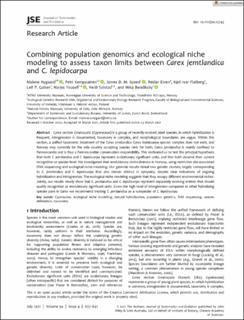| dc.contributor.author | Nygård, Malene Østreng | |
| dc.contributor.author | Kemppainen, Petri | |
| dc.contributor.author | Speed, James D. M. | |
| dc.contributor.author | Elven, Reidar | |
| dc.contributor.author | Flatberg, Kjell Ivar | |
| dc.contributor.author | Galten, Leif Persen | |
| dc.contributor.author | Yousefi, Narjes | |
| dc.contributor.author | Solstad, Heidi | |
| dc.contributor.author | Bendiksby, Mika | |
| dc.date.accessioned | 2022-04-06T11:35:13Z | |
| dc.date.available | 2022-04-06T11:35:13Z | |
| dc.date.created | 2021-08-10T14:14:09Z | |
| dc.date.issued | 2021 | |
| dc.identifier.citation | Journal of Systematics and Evolution. 2021, 59 (4), 627-641. | en_US |
| dc.identifier.issn | 1674-4918 | |
| dc.identifier.uri | https://hdl.handle.net/11250/2990202 | |
| dc.description.abstract | Carex section Ceratocystis (Cyperaceae) is a group of recently evolved plant species, in which hybridization is frequent, introgression is documented, taxonomy is complex, and morphological boundaries are vague. Within this section, a unified taxonomic treatment of the Carex jemtlandica–Carex lepidocarpa species complex does not exist, and Norway may currently be the sole country accepting species rank for both. Carex jemtlandica is mainly confined to Fennoscandia and is thus a Fennoscandian conservation responsibility. This motivated us to test the principal hypothesis that both C. jemtlandica and C. lepidocarpa represent evolutionary significant units, and that both deserve their current recognition at species level. We investigated their evolutionary distinctiveness in Norway, using restriction site-associated DNA sequencing and ecological niche modeling. Our genomic results reveal two genetic clusters, largely corresponding to C. jemtlandica and C. lepidocarpa that also remain distinct in sympatry, despite clear indications of ongoing hybridization and introgression. The ecological niche modeling suggests that they occupy different environmental niches. Jointly, our results clearly show that C. jemtlandica and C. lepidocarpa represent separately evolving entities that should qualify recognition as evolutionary significant units. Given the high level of introgression compared to other hybridizing species pairs in Carex we recommend treating C. jemtlandica as a subspecies of C. lepidocarpa. | en_US |
| dc.language.iso | eng | en_US |
| dc.publisher | Wiley | en_US |
| dc.rights | Navngivelse 4.0 Internasjonal | * |
| dc.rights.uri | http://creativecommons.org/licenses/by/4.0/deed.no | * |
| dc.title | Combining population genomics and ecological niche modeling to assess taxon limits between Carex jemtlandica and C. lepidocarpa | en_US |
| dc.type | Journal article | en_US |
| dc.type | Peer reviewed | en_US |
| dc.description.version | publishedVersion | en_US |
| dc.source.pagenumber | 627-641 | en_US |
| dc.source.volume | 59 | en_US |
| dc.source.journal | Journal of Systematics and Evolution | en_US |
| dc.source.issue | 4 | en_US |
| dc.identifier.doi | 10.1111/jse.12743 | |
| dc.identifier.cristin | 1925088 | |
| cristin.ispublished | true | |
| cristin.fulltext | original | |
| cristin.qualitycode | 1 | |

